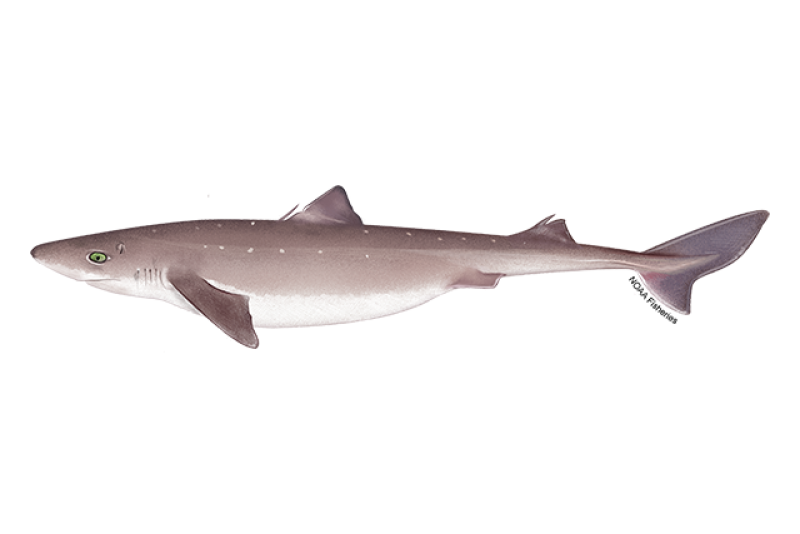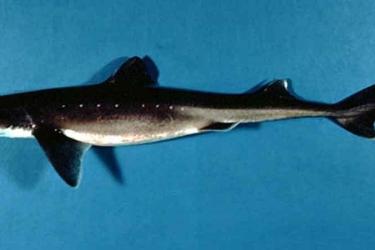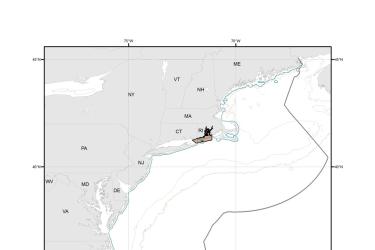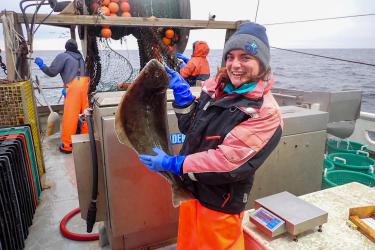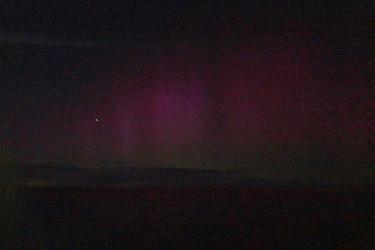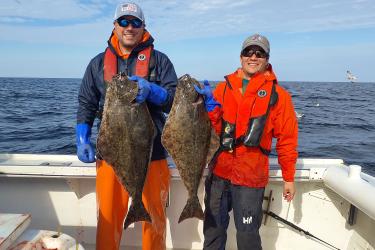Atlantic Spiny Dogfish
 Spiny dogfish. Credit: National Ocean Service
Spiny dogfish. Credit: National Ocean Service
Spiny dogfish. Credit: National Ocean Service
About the Species
 Spiny dogfish. Credit: National Ocean Service
Spiny dogfish. Credit: National Ocean Service
Spiny dogfish. Credit: National Ocean Service
The Atlantic spiny dogfish fishery operates from Maine to Florida and from inshore to offshore waters on the edge of the continental shelf. The spiny dogfish fishery uses predominantly bottom gillnets, with lesser amounts caught by trawls and hook gear. There is little consumer demand for spiny dogfish in the United States, but it is commonly used in Europe as the fish in 'fish and chips.' U.S. wild-caught Atlantic spiny dogfish is a smart seafood choice because it is sustainably managed and responsibly harvested under U.S. regulations. Implementing regulations are found at 50 CFR part 648 subpart L.

Population
The stock is not overfished.

Fishing Rate
Not subject to overfishing.

Habitat Impact
Area closures and gear restrictions protect habitats affected by some kinds of trawl gear.

Bycatch
Regulations are in place to minimize bycatch.
Population Status
- According to the 2023 stock assessment, Atlantic spiny dogfish is not overfished and not subject to overfishing. Summary stock assessment information can be found on Stock SMART.
- Scientists project that the number of mature females may decline somewhat in the coming years due to the low number of pups born during the 1990s when spiny dogfish were heavily fished. This potential decline is not expected to result in the stock becoming overfished.
Appearance
- Spiny dogfish are slim, with a narrow, pointed snout and characteristic white spots.
- They are gray above and white below.
- They have two dorsal fins with ungrooved large spines.
- Males grow up to 3.3 feet, and females grow up to 4 feet.
Biology
- Like all sharks, dogfish grow slowly, mature late in life, and live a long time (35 to 40 years).
- Females grow larger and mature later than males—they’re first able to reproduce at age 12 compared to males at age 6.
- They spawn in winter in offshore waters.
- Females have between two and 12 eggs per spawning season. The eggs are fertilized internally and, after a gestation period of 18 to 24 months, female dogfish bear live young (an average of six pups).
- They are opportunistic feeders, preying on whatever is most available.
- Smaller spiny dogfish tend to feed primarily on crustaceans, while larger dogfish like to eat jellyfish, squid, and schooling fish.
- Dogfish are preyed upon by cod, red hake, goosefish, other spiny dogfish, larger sharks, seals, and orcas.
Where They Live
Range
- Spiny dogfish are found in the North Atlantic and North Pacific Oceans, mostly in the temperate and subarctic areas. In the Northwest Atlantic, they are found from Labrador to Florida and are most abundant between Nova Scotia and Cape Hatteras.
Habitat
- Spiny dogfish live inshore and offshore, usually near the bottom but also in mid-water and at the surface.
- They swim in large schools and migrate seasonally with changes in water temperature.
- Much of the population travels north in the spring and summer and south in the fall and winter.
- Some spiny dogfish remain in northern waters throughout the year and move offshore during the winter.
Fishery Management
- NOAA Fisheries, the Mid-Atlantic and New England Fishery Management Councils, and the Atlantic States Marine Fisheries Commission manage the Atlantic spiny dogfish fishery.
- The Mid-Atlantic Council leads the joint management of the Spiny Dogfish Fishery Management Plan:
- Fishermen must have a permit to harvest spiny dogfish.
- Annual catch limits and a commercial quota are set.
- Trip limits used to control the catch rate.
- The Atlantic States Marine Fisheries Commission implements the Interstate Fishery Management Plan for Spiny Dogfish in state waters, establishing complementary regulations to the federal regulations.
Harvest
- In 2023, commercial landings of spiny dogfish in the Atlantic totaled approximately 11 million pounds, and were valued at $2.4 million, according to the NOAA Fisheries commercial fishing landings database.
- The U.S. commercial fishery supplies European markets that use dogfish for fish and chips in England, and as a popular beer garden snack called shillerlocken in Germany.
- Gear types, habitat impacts, and bycatch:
- Atlantic spiny dogfish are targeted by gillnet and longline vessels, mainly in state waters.
- They are often caught incidentally in trawl, gillnet, and longline fisheries for groundfish species.
- Trawls can impact habitat, depending on where they are used.
- Managers have implemented a variety of measures for groundfish trawl fisheries to protect habitat, including closing some areas to fishing and modifying fishing gear to reduce contact with habitat.
- Trawl and gillnet fisheries for groundfish can incidentally catch other fish and marine mammals (such as large whales, harbor porpoises, bottlenose dolphins) and sea turtles. Restrictions on gear and fishing effort in these fisheries reduce these interactions.
Scientific Classification
- Spiny dogfish are found in the North Atlantic and North Pacific Oceans, mostly in the temperate and subarctic areas. In the Northwest Atlantic, they are found from Labrador to Florida and are most abundant between Nova Scotia and Cape Hatteras.
- Spiny dogfish live inshore and offshore, usually near the bottom but also in mid-water and at the surface.
- They swim in large schools and migrate seasonally with changes in water temperature.
- Much of the population travels north in the spring and summer and south in the fall and winter.
- Some spiny dogfish remain in northern waters throughout the year and move offshore during the winter.
Fishery Management
- NOAA Fisheries, the Mid-Atlantic and New England Fishery Management Councils, and the Atlantic States Marine Fisheries Commission manage the Atlantic spiny dogfish fishery.
- The Mid-Atlantic Council leads the joint management of the Spiny Dogfish Fishery Management Plan:
- Fishermen must have a permit to harvest spiny dogfish.
- Annual catch limits and a commercial quota are set.
- Trip limits used to control the catch rate.
- The Atlantic States Marine Fisheries Commission implements the Interstate Fishery Management Plan for Spiny Dogfish in state waters, establishing complementary regulations to the federal regulations.
Harvest
- In 2023, commercial landings of spiny dogfish in the Atlantic totaled approximately 11 million pounds, and were valued at $2.4 million, according to the NOAA Fisheries commercial fishing landings database.
- The U.S. commercial fishery supplies European markets that use dogfish for fish and chips in England, and as a popular beer garden snack called shillerlocken in Germany.
- Gear types, habitat impacts, and bycatch:
- Atlantic spiny dogfish are targeted by gillnet and longline vessels, mainly in state waters.
- They are often caught incidentally in trawl, gillnet, and longline fisheries for groundfish species.
- Trawls can impact habitat, depending on where they are used.
- Managers have implemented a variety of measures for groundfish trawl fisheries to protect habitat, including closing some areas to fishing and modifying fishing gear to reduce contact with habitat.
- Trawl and gillnet fisheries for groundfish can incidentally catch other fish and marine mammals (such as large whales, harbor porpoises, bottlenose dolphins) and sea turtles. Restrictions on gear and fishing effort in these fisheries reduce these interactions.
Scientific Classification
| Kingdom | Animalia | Phylum | Chordata | Class | Chondrichthyes | Order | Squaliformes | Family | Squalidae | Genus | Squalus | Species | acanthias |
|---|
Last updated by NOAA Fisheries on 05/12/2025
Featured News
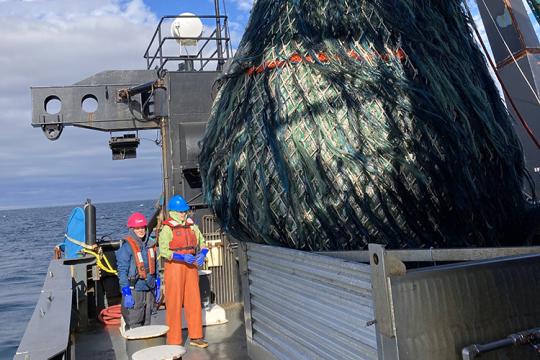 After each survey tow, the net is retrieved and the catch is emptied into a hopper where a series of conveyors move the catch to the sorting and processing area aboard the NOAA Ship Henry B. Bigelow. There, scientists sort the catch and collect data and biological samples. Credit: NOAA Fisheries/Jessica Blaylock
After each survey tow, the net is retrieved and the catch is emptied into a hopper where a series of conveyors move the catch to the sorting and processing area aboard the NOAA Ship Henry B. Bigelow. There, scientists sort the catch and collect data and biological samples. Credit: NOAA Fisheries/Jessica Blaylock

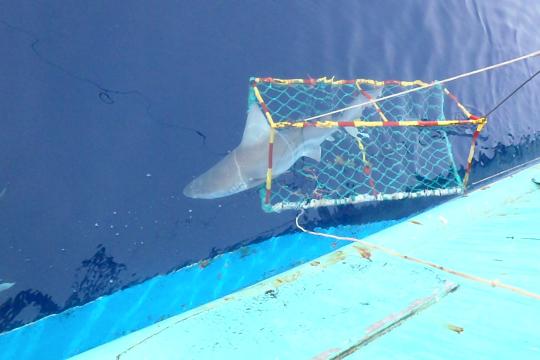 Releasing a sandbar shark on a shark survey.
Releasing a sandbar shark on a shark survey.

Recreational Fishing Regulations
There are currently no recreational possession restrictions for spiny dogfish caught in federal waters. Recreational anglers must still comply with applicable state regulations when in state waters (including transiting, unless state regulations address transiting), and are subject to the most restrictive regulations when fishing or transiting multiple jurisdictions.
Recreational anglers will need to get a general recreational fishing license either through your state or through NOAA Fisheries to fish recreationally for marine species. Find out how to get a permit or visit recreational fishing pages for more information.
Last updated by NOAA Fisheries on 05/12/2025
Commercial Fishing Regulations
Possession and Size Requirements
The federal commercial trip limit for spiny dogfish is 7,500 lb. Only one trip may be made each calendar day.
There are no fish size limits in the spiny dogfish.
Note: Individual states may set more restrictive possession limits. Please check with your state fisheries agency.
2025 Spiny Dogfish Specifications
| Acceptable Biological Catch (ABC) | 16.81 million lb |
|---|---|
| Annual Catch Limit (ACL) | 9.58 million lb |
| Commercial Quota | 9.34 million lb |
Inseason Actions
If the coast-wide commercial spiny dogfish quota is fully harvested, then the commercial spiny dogfish fishery will be closed.
Accountability Measures (AM)
If the spiny dogfish ACL is exceeded, the exact amount in pounds by which the ACL was exceeded shall be deducted, as soon as possible, from a subsequent single fishing year ACL.
Reporting A Commercial Catch
Catch Reporting and Vessel Trip Reports (VTR)
Owners/operators of vessels holding a federal dogfish permit must submit VTRs electronically. For more information about trip reporting, and to see a list of approved eVTR software applications, please visit the Greater Atlantic Region vessel trip reporting page.
Vessel Monitoring System (VMS)
The commercial spiny dogfish fishery does not specifically require VMS. However, vessels must abide by Northeast multispecies, scallop, or monkfish regulations if fishing on a day-at-sea (DAS) for one of those fisheries. Unless fishing on a Northeast multispecies sector trip, a vessel holding a federal fishing permit that requires an operating VMS must declare ‘out of fishery’ (DOF) through their VMS before starting a trip to fish for, possess, or land spiny dogfish in an exempted area or fishery not requiring a DAS.
Other Reporting Information
The commercial spiny dogfish fishery does not have any Interactive Voice Response (IVR, accessible via FishOnline) or specific observer requirements. However, vessels must abide by Northeast multispecies, scallop, or monkfish regulations if fishing on a DAS for one of those fisheries. Additionally, all federally permitted vessels are obligated to carry an observer if randomly selected by the National Observer Program.
Commercial Gear Information
In general, unless exempted, spiny dogfish vessels fishing in federal waters are subject Northeast multispecies (groundfish) regulations, regardless of whether or not they also have a NE multispecies permit. Under these regulations, there are four regulated mesh areas (RMA) that control the gear that can be used in each area (see map): Gulf of Maine (GOM); Georges Bank (GB); Southern New England (SNE); and Mid-Atlantic (MA).

Within these RMAs, vessels fishing with gillnets and trawl gear must abide by the minimum mesh sizes required by the NE multispecies regulations. This consists of essentially a 6.5-inch minimum mesh size for square of diamond mesh for both trawl and gillnet gear in all RMAs. In the gillnet fishery, nets may not be longer than 300 ft / 91.4 m / 50 fathoms in length.
Vessels holding a limited access Northeast multispecies permit, and not on a Northeast multispecies sector trip, must also comply with the Northeast multispecies Restricted Gear Areas (RGAs). More information on RGAs can be found on our Northeast multispecies pages and regulations.
Vessels possessing a spiny dogfish permit fishing with gillnet gear must comply with overnight soak prohibitions in the Atlantic Sturgeon Bycatch Reduction Areas. These are:
- New Jersey Atlantic Sturgeon Bycatch Reduction Area
- Delaware/Maryland Atlantic Sturgeon Bycatch Reduction Area
- Virginia Atlantic Sturgeon Bycatch Reduction Area
For more information, including maps of these areas, follow the links above or in the More Information box on this page.
More information on the gears allowed and involved with spiny dogfish fishery exemptions can be found on the Exempted Fishing tab on this page.
In addition to the gear requirements above, protected species requirements may also apply, depending on the season and area being fished.
Last updated by NOAA Fisheries on 05/12/2025
Seafood Facts

Is Atlantic Spiny Dogfish Sustainable?
U.S. wild-caught Atlantic spiny dogfish is a smart seafood choice because it is sustainably managed and responsibly harvested under U.S. regulations.
Availability
Year-round.
Source
U.S. wild-caught from Maine to North Carolina.
Taste
Mild and sweet.
Texture
Flaky but firm. It has higher oil content than mako or other sharks.
Color
The raw meat is white. The outer flesh can have a reddish hue, which turns brown when cooked. The rest of the meat remains white when cooked.
Health Benefits
Shark is a low-fat source of protein and is high in selenium and vitamins B6 and B12.
Nutrition Facts
Servings: 1; Serving Weight: 100 g (raw); Calories: 130; Protein: 20.98 g ; Total Fat: 4.51 g; Total Saturated Fatty Acids: 0.925 g; Carbohydrate: 0 g; Total Sugars: 0 g; Total Dietary Fiber: 0 g; Cholesterol: 51 mg; Selenium: 36.5 mcg; Sodium: 79 mgMore Information
Last updated by NOAA Fisheries on 05/12/2025
Seafood News
 Celebrate Culinary Arts Month with a sustainable seafood recipe for every month of the year.
Celebrate Culinary Arts Month with a sustainable seafood recipe for every month of the year.
What Your Birth Month Says About Your Next Seafood Recipe
 Fresh-caught taʻape on ice. Credit: Conservation International Hawaiʻi.
Fresh-caught taʻape on ice. Credit: Conservation International Hawaiʻi.
Reducing Waste and Feeding Communities in Hawaiʻi with a Whole Fish Approach
 Chef Tyler Hadfield’s Curried Skate Wings with Tomato-Masala Chutney
Chef Tyler Hadfield’s Curried Skate Wings with Tomato-Masala Chutney
Ring In the New Year With These Crowd-Favorite Seafood Recipes
 NOAA Fisheries, in collaboration with Blue Ocean Mariculture, is conducting a multi-year pilot study to evaluate observational methods and tools for studying Hawaiian monk seal behavior. Courtesy of Blue Ocean Mariculture
NOAA Fisheries, in collaboration with Blue Ocean Mariculture, is conducting a multi-year pilot study to evaluate observational methods and tools for studying Hawaiian monk seal behavior. Courtesy of Blue Ocean Mariculture
AI Meets Aquaculture to Study Hawaiian Monk Seal Interactions With Net Pens
Exempted Fishing
What is an Exempted Fishery?
Exempted fisheries allow vessels to fish for specific species without being subject to certain Northeast multispecies regulations, including days-at-sea, provided the bycatch of regulated species is minimal. To be approved and implemented, exemption programs must have demonstrated that incidental catch of Northeast multispecies is less than five percent of the total catch, by weight, and that the exemption will not jeopardize fishing mortality objectives.
Spiny Dogfish Fishery Exemptions
Within the Gulf of Maine (GOM) and Georges Bank (GB) Regulated Mesh Areas (RMA) there are six exempted fishing areas that are summarized in the table below. More specific details for each area can be found on the linked pages within the table. A Letter of Authorization (LOA) is required to participate in some of these exempted fishing areas. LOAs can be obtained from our Permits Office at 978-282-8438, or online on the permits site.
Gulf of Maine and Georges Bank Spiny Dogfish Exemption Areas
| Area Name | Season | Gear Allowed | LOA Required? |
|---|---|---|---|
| Nantucket Shoals Dogfish Exemption Area | June 1 - October 15 | Trawl, gillnet | Yes |
| Cultivator Shoal Whiting Fishery Exemption Area | June 15 - October 31 | Trawl | Yes |
| Small Mesh Areas 1 & 2 | SMA 1: July 15 - November 15 SMA 2: January 1 - June 30 | Trawl | No |
| Raised Footrope Trawl Whiting Fishery Areas | September 1 - November 20 / December 31 | Trawl | Yes |
| GOM/GB Dogfish Gillnet Exemption Area | July 1 - August 31 | Gillnet | No |
| Cape Cod Spiny Dogfish Exemption Areas | June 1 - August 31 / December 31 | Gillnet, Longline, Handgear | No |
There are two exempted fishing areas in the Southern New England (SNE) RMA and one exempted fishing area in the Mid-Atlantic (MA) RMA that are summarized in the table below. More specific details for each area can be found on the linked pages within the table.
Southern New England and Mid-Atlantic Spiny Dogfish Exemption Areas
| Area Name | Season | Gear Allowed | LOA Required? |
|---|---|---|---|
| SNE Exemption Area (includes part of the GB RMA) | Year round | Trawl | No |
| SNE Dogfish Gillnet Exemption Area | May 1 - October 31 | Gillnet | No |
| MA Exemption Area (includes part of the SNE RMA) | Year round | Trawl, gillnet | No |
All vessels fishing for spiny dogfish in federal waters must also comply with closed areas for other fisheries, including Northeast multispecies, unless they are fishing with gear that has been deemed 'exempt' and unable to catch those controlled species.
Exempted gear that has been defined as not capable of catching Northeast multispecies includes the following: Pelagic hook and line, pelagic longline, spears, rakes, diving gear, cast nets, tong, harpoons, weirs, dipnets, stop nets, pound nets, pelagic gillnets, pots and traps, shrimp trawls (with properly configured grates), and surfclam/ocean quahog dredges.
Last updated by NOAA Fisheries on 05/12/2025
Management Overview
The Atlantic spiny dogfish fishery is jointly managed in state and federal waters by the Mid-Atlantic Fishery Management Council (lead) and the New England Fishery Management Council, in conjunction with the Atlantic States Marine Fisheries Commission. NOAA Fisheries serves as the implementing body for rules and regulations within the fishery.
The fishing year runs from May 1 through April 30, with NOAA Fisheries Greater Atlantic Region jurisdiction covering spiny dogfish from Maine to North Carolina. The fishery is managed using a coastwide annual quota and possession limits.
While there are no specified management areas for the fishery, vessels fishing for spiny dogfish in federal waters must also comply with closed areas for NE multispecies and other fisheries, unless using gear defined as not capable of catching NE multispecies or in an exempted fishing area. There are several exempted fishing areas defined for the spiny dogfish fishery, which you can learn more about on the Exempted Fishing tab on this page.
Control Date for the Spiny Dogfish Fishery: May 18, 1998
Specifications/Quotas
The Spiny Dogfish Fishery Management Plan (FMP) requires the annual specification of catch and harvest limits for up to five years at a time. If specifications are not in place at the start of the fishing year, the existing specifications roll over until new regulations are finalized. Please see the spiny dogfish commercial fishing page for more information on current specifications.
Regulatory History
- Late 1980s – Atlantic spiny dogfish fishery develops rapidly as international markets opened due to a rapid decline in European dogfish stocks.
- 1990 – Landings recorded at more than 30 million pounds (13,608 metric tons), tripling the landings in 1989.
- 1995-1999 – Landings average 50 million pounds (22,680 metric tons) annually.
- 1998 – Spiny dogfish classified as overfished as a result of an increased directed fishery, due to the decline in abundance of traditional groundfish.
- 2000 – Spiny Dogfish Fishery Management Plan implemented, establishing management of Atlantic spiny dogfish fisheries and initiating stock rebuilding.
- 2006 – Framework 1 created a mechanism for specification of multi-year management measures.
- 2007 – Amendment 1 standardized bycatch reporting methodology.
- 2008 – Spiny dogfish estimated to be above the target biomass level.
- 2009 – Framework 2 built flexibility into process to define and update status determination criteria; NOAA Fisheries increases quota from 3 million to 12 million pounds and trip limit from 600 to 3,000 pounds for 2009 fishing year.
- 2010 – Spiny dogfish are declared rebuilt; catch levels for the dogfish fishery increase from 12 million pounds to 15 million pounds in 2010.
- 2011 – Amendment 2 established annual catch limits and accountability measures; NOAA Fisheries increases catch levels for the dogfish fishery by 33% to 20 million pounds.
- 2014 – Amendment 3 established a new Research Set-Aside program and rollover of specifications from one year to the next, as well as eliminated the seasonal allocation of quota.
- 2015 – Amendment 4 implemented Standardized Bycatch Reporting Methodology.
- 2017 – Amendment 5 implemented management measures to prevent the development of new, and the expansion of existing, commercial fisheries on certain forage species in the Mid-Atlantic.
- 2018 – Framework 3 established a process for setting constant multi-year acceptable biological catch (ABC) limits. This action also clarifies the process for setting ABCs for each of the four types of ABC control rules.
- 2024 - Framework 6 implemented area-based gear restrictions to reduce bycatch of Atlantic sturgeon in the spiny dogfish gillnet fishery.
More Information
- e-CFR for Spiny Dogfish Fishery Regulations
- Mid-Atlantic Fishery Management Council Spiny Dogfish Page
- Atlantic States Marine Fisheries Commission Spiny Dogfish Page
- New England Fishery Management Council Spiny Dogfish Page
- Spiny Dogfish Fishery Management Plan
- Spiny Dogfish Permits Page
- Fishing Industry Home Page
Last updated by NOAA Fisheries on 05/12/2025
Science Overview
NOAA Fisheries conducts various research activities on the biology, behavior, and population health of Atlantic spiny dogfish. The results of this research are used to inform management decisions for this species.
For detailed information about stock status, management, assessments, and resource trends, you can search for Atlantic spiny dogfish, and any other species of interest, using NOAA’s StockSMART web tool.
Atlantic Spiny Dogfish Research in the Northeast
In June 2011, NOAA’s Northeast Fisheries Science Center launched a cooperative initiative to tag spiny dogfish. The project is designed to answer long-standing questions about stock structure, movement patterns, and life history to update and improve dogfish stock assessments.
A Scientific Fishery for Atlantic Spiny Dogfish
There is a small scientific fishery for Atlantic spiny dogfish in Maine, which uses spiny dogfish to study several of the species’ unique biological characteristics. For example, studies of dogfish rectal glands help scientists better understand the function of human kidneys. Dogfish also secrete a compound called squalamine, which has strong antibiotic characteristics and shows promise as an anti-cancer agent.
More Information
Recent Science Blogs
Last updated by NOAA Fisheries on 05/12/2025
Data & Maps
Research
Northeast Shark Research
We conduct shark life history research and long-term monitoring activities essential for stock assessment and management.
Last updated by NOAA Fisheries on 05/12/2025
